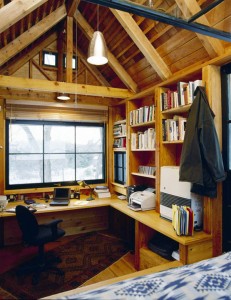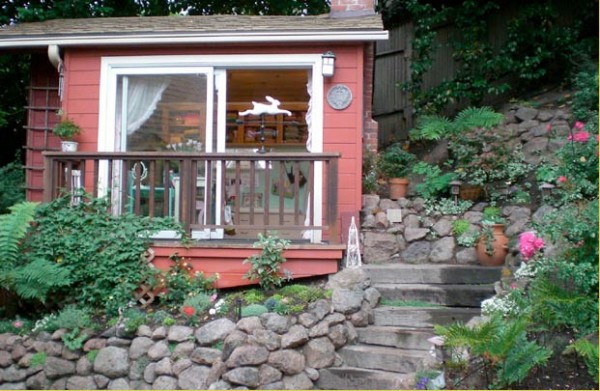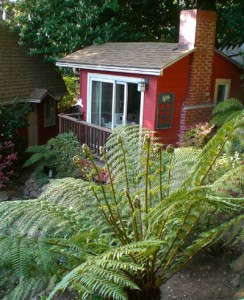Lori Marie is an artist/craftista who works out of a tiny house in her backyard in Oakland. She fills it with her crafting supplies, sewing machine and computer, her French bulldog Matilda, and lots of color. Her pretty little studio has a tiny deck and even a tiny garden. She said the prior owners of her house built the studio over an old foundation and fireplace, which no longer works.
“My favorite time of year is when the roses are in bloom on the hillside and the hummigbirds are buzzing around the passion flower vine,” she said. It really feels like a wonderland and is the perfect little place to bring all of my ideas to life.”
Artists’ retreats have been around as far back as Thoreau’s cabin on Walden Pond. The common theme of each seems to be a tiny space, usually one room, just for writing, poetry, painting and other creative skills.


Michael Pollan’s desire for his own getaway was so strong that he spent two years building his tiny writer’s cabin and wrote about his triumphs and frustrations in his book, A Place of My Own.
Kristina Lindbergh, the granddaughter of Charles and Anne Morrow Lindbergh also had a 12-ft. by 12-ft. writer’s retreat built for her by her brother and sister-in-law. The tiny cabin has space for writing, a few shelves for books and a sleeping loft. You can see her tiny cabin in the book, The Cabin: Inspiration for the Classic American Getaway
One of the nice things about a tiny artist retreat is that it can be built in a backyard or close enough to a house to take advantage of the convenience, but still feel like an escape from the big house world.
Ideas for Great Backyard Cottages
If you enjoyed this post, subscribe to our feed




Simply wonderful! These tiny cottages would bring out the artist in anyone. Thank you for finding such great tiny getaways to share with your faithful followers!
This is pretty good… I was considering doing something like this for an outside reading area to relax and get out of the house.
That’s beautiful, looks like a fantastic retreat.
My understanding is that little buildings like these don’t require permits to build in many communities. The are technically sheds and simply have to meet shed height, set back, square footage requirements. But when you start running power and plumbing to them you might start to run into building code issues if you’re trying to keep it legal. Back in my 20s I build a little 10×16 pottery studio like this. My power was supplied by an extension code. My electric kiln shared the power outlet with my dryer on the porch of the nearby cabin. Cue the banjos! 🙂
great retreats, I wish I could work in any of these, so inspiring
Consigue tu perfil de forma gratuita